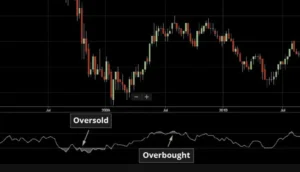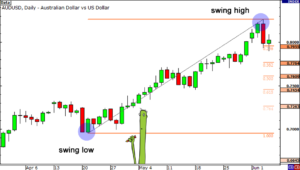Technical analysis is a method used by investors to predict future price movements based on past data. Two important concepts in technical analysis are support and resistance. To understand the question, What are support and resistance in technical analysis?, one must know how these concepts affect the market.
Support refers to a price level where a stock tends to stop falling because demand increases. This level acts as a bottom where buying interest is greater than selling pressure, often leading to a price increase.
Resistance, on the other hand, is a level where the price has difficulty rising further because selling pressure increases. Here it acts as a ceiling where selling interest is greater than buying pressure, usually resulting in a price decrease.
Understanding support and resistance levels is crucial for success in stock trading:
- Identification of Entry and Exit Points: By knowing where the support levels are located, investors can find good buying opportunities. Similarly, resistance levels can indicate when it is wise to sell.
- Risk and Capital Management: Knowledge of these levels helps in setting stop-loss orders and maximizing profits.
For those who use technical analysis of stocks, ProInvestor offers a comprehensive toolbox for finding support and resistance levels using advanced algorithms and visual indicators.
What is support in technical analysis?
Definition of support and how it works in price movements
Support refers to a price level at which a stock tends to stop its decline due to increased demand. This means that when the price of a stock falls to a support level, buyers often step in, preventing further decline. Support can be seen as a bottom on a price curve, where sellers become less willing to sell below this level.
Methods for Identifying Support Levels
Several methods are used to identify support levels:
- Historical Lows: Previous lowest prices can indicate future support levels.
- Round Numbers: Price levels that end in round numbers (e.g., 50, 100) often serve as psychological barriers.
- Moving Averages: Long moving averages, such as 200-day or 50-day, can also act as dynamic support levels.
- Volume: Volume analysis can reveal how significant support and resistance are. Higher trading volume at certain price levels indicates stronger support or resistance.
- Price-by-Volume: Price-by-Volume (PBV) shows a histogram along the Y-axis indicating volume at given price levels and can be a way to identify support levels.
Buy Signal at Support Levels
When a stock reaches an identified support level, it can be interpreted as a buy signal. Investors often look for the price to show signs of stabilization at this level before making purchases. This provides a better entry point with reduced risk of further price declines.
By understanding and utilizing support, investors can increase the likelihood of successful trades.
What is resistance in technical analysis?
Resistance refers to a price level where a stock or other financial instrument has difficulty breaking through because a large number of investors are willing to sell at this level. When the price approaches a resistance level, selling activity increases, which often results in the price falling back.
Methods for identifying resistance levels
There are several techniques for identifying resistance levels:
- Historical highs: Previous peaks in the stock price can indicate potential resistance levels. For example, if a stock has previously reached a high of 100 kroner and then fell back, 100 kroner can serve as a future resistance level.
- Round numbers: Psychologically important levels such as round numbers (for example, 50, 100, 150) often act as resistance levels. Investors tend to place their sell orders around these levels.
- Volume: Volume analysis can reveal how significant support and resistance are. Higher trading volume at certain price levels indicates stronger support or resistance.
- Price-by-Volume: Price-by-Volume (PBV) shows a histogram along the Y-axis indicating volume at given price levels and can be a way to identify resistance levels.
Sell signal at resistance levels
When the price reaches a resistance level, and it is observed that the volume of sales increases without the price being able to break through this level, a sell signal is generated. This indicates that it may be advantageous to sell or short the stock with the expectation of a price decline.
A typical example could be a stock that rises to 150 kroner (a round number) but fails several times to break through this level. This will be a strong signal of resistance.
By using these methods to identify resistance levels, investors can make more informed decisions about when to sell their positions.
The Relationship Between Support and Resistance
Support and resistance serve as important reference points in a price chart. The support level represents a price level where a stock has had difficulty falling below, due to increased buying interest. On the other hand, the resistance level is a price level where a stock has had difficulty rising above, due to increased selling pressure.
- When a stock approaches a support level, it is expected that the price will stop falling and start rising again.
- Similarly, when a stock approaches a resistance level, it is expected that the price will stop rising and start falling.
These levels can often be interchanged; when a support level is broken, it can become a new resistance level and vice versa. This phenomenon is frequently observed in technical analysis and provides important signals for trading strategies.
Example: If a stock has support at 50 kroner and resistance at 60 kroner, investors will often buy near 50 kroner and sell near 60 kroner.
Understanding these dynamics between support and resistance allows investors to make more informed decisions based on historical price movements.
Formations
Formations in technical analysis can provide valuable signals for when to buy or sell. These formations occur as a result of patterns in price movements, and they play a critical role in identifying future price movements.
What are trendlines?
Trendlines are an important part of formations, as they help identify support and resistance levels. A trendline is drawn by connecting significant low points in an upward trend or high points in a downward trend. This allows for visualizing the trend and provides insight into where the price is likely to encounter support or resistance.
Methods of Technical Analysis
There are several technical analysis methods that use formations to predict future price movements:
- Head and Shoulders Formation: A pattern that signals a reversal of the trend.
- Double Top and Double Bottom: Indicates a potential decline or rise, respectively.
- Rectangles: Symmetrical, ascending or descending rectangles that show consolidation before a breakout.
Market Psychology
The use of trendlines to visualize support and resistance on a price chart helps to understand market psychology. For example, when the price approaches an established support line, investors may see this as a buying signal. Similarly, proximity to a resistance line can be interpreted as a selling signal.
A deep understanding of these formations and the use of trend lines provides investors with the tools they need to make informed decisions based on historical price movements.
Investors’ Psychological State and Trading Strategies at Support and Resistance
Understanding the psychological state of investors is crucial when analyzing support and resistance in the stock market. Market psychology plays a central role in how price levels are formed and how investors react to them.
Psychological Factors
- Fear and Greed: These emotions drive many investment decisions. At support levels, there is often fear of further losses, while at resistance levels, greed for further gains can dominate.
- Mass Suggestion: Price movements are strongly influenced by collective decisions. When a large number of investors identify and react to the same support or resistance level, these levels are reinforced.
Trading Strategies
Identifying support and resistance stocks provides several strategic opportunities:
- Buying Strategy at Support: When the price approaches a support level, it can be advantageous to buy, as the probability of a price increase increases. Volume balance and historical lows are used to confirm the strength of the support.
- Selling Strategy at Resistance: At resistance levels, selling is considered, as the risk of a price decline is higher. Historical highs and round numbers help identify strong resistance.
Practical Example
A stock that has fallen to its previous support level of 100 kr can be seen as an attractive buy if the volume balance is positive. Conversely, when the same stock approaches 150 kr, which has previously been a strong resistance level, it may be wise to consider selling.
This example illustrates how understanding market psychology combined with technical analysis can improve trading decisions.


